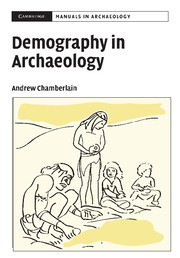Book contents
5 - EVOLUTIONARY AND GENETIC PALAEODEMOGRAPHY
Published online by Cambridge University Press: 02 December 2009
Summary
AGE AND SEX STRUCTURE IN ANIMAL POPULATIONS
Natural animal populations
Demographic profiles and life tables have been obtained for many animal species, using data obtained either from the age structure of stable and stationary animal populations or from recorded ages at death of representative samples of animal mortality. Many vertebrate species resemble humans in possessing a two-component age-specific attritional mortality pattern, with a juvenile phase where initially high mortality rates decline rapidly as the animal matures and a post-juvenile phase where mortality rates either stabilise or increase slowly but progressively with age (Deevey, 1947; Caughley, 1966: 916, see also Figure 5.1).
In most mammals the sex ratio at birth averages close to unity, though in some species there may be considerable variance in the sex ratio of offspring, especially in polygynous animals (Trivers and Willard, 1973). Mortality rates can also differ substantially between the sexes, with male animals often experiencing higher age-specific mortality as a result of reproductive competition and exclusion of subordinate males from access to resources. As a result the adult sex ratio in wild-animal populations is frequently biased towards females (Collier and White, 1976).
Demography of non-human primates
Humans and non-human primates exhibit the general mammalian demographic pattern of high infant mortality, followed by decreasing mortality in the juvenile years and increasing age-specific mortality rates in later adulthood (Dunbar, 1987; Gage, 1998).
- Type
- Chapter
- Information
- Demography in Archaeology , pp. 133 - 150Publisher: Cambridge University PressPrint publication year: 2006

